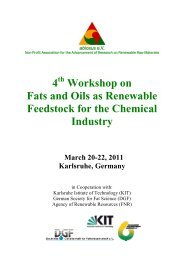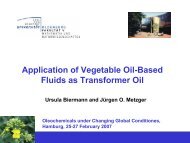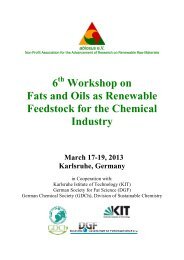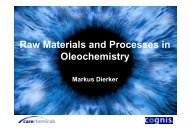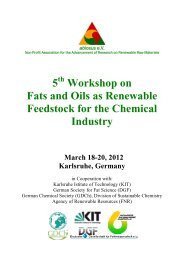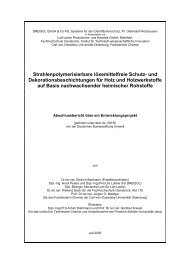Fats and Oils as Renewable Feedstock for the Chemical ... - abiosus
Fats and Oils as Renewable Feedstock for the Chemical ... - abiosus
Fats and Oils as Renewable Feedstock for the Chemical ... - abiosus
Create successful ePaper yourself
Turn your PDF publications into a flip-book with our unique Google optimized e-Paper software.
L9Olefin Meta<strong>the</strong>sis of Fatty Acids: On <strong>the</strong> Way to Industrial RealizationHerbert RieplInstitute of Resource- & Energy Technology, Technical University of Munichh.riepl@wz-straubing.deOlefinmeta<strong>the</strong>sis is a transition metal catalyzed reaction of olefinic double bonds, wherebya <strong>for</strong>mal exchange of substituents occurs. According to a suggestion originally made byChauvin <strong>the</strong> reaction mechanism is not an exchange of substituents but a complete break<strong>and</strong> re<strong>for</strong>mation of <strong>the</strong> olefinic bond with metal-carbene complexes <strong>as</strong> catalytically activeintermediates. Quite different transition metal carbene complexes are able to catalyse thisreaction <strong>and</strong> some technical processes b<strong>as</strong>ed on tungsten, molybdenum or rhenium havebeen designed. In <strong>the</strong> l<strong>as</strong>t decade a huge progress h<strong>as</strong> been made in <strong>the</strong> meta<strong>the</strong>sischemistry by ru<strong>the</strong>nium 1 . The first consideration of unsaturated fatty acids <strong>as</strong> source ofdouble bonds <strong>and</strong> useful chemicals with carbon chains of intermediate carbonatomnumber h<strong>as</strong> been made by Boelhouwer 2 . Using tungsten halides, he established <strong>the</strong> b<strong>as</strong>icchemistry of <strong>the</strong> fatty acid meta<strong>the</strong>sis but with low per<strong>for</strong>mance. Olefinic chemistry of <strong>the</strong>double bond in unsaturated fatty acids h<strong>as</strong> been confined since mainly to epoxidationchemistry up to now, because <strong>the</strong> usual metal carben catalyst precursors are highlyreactive towards <strong>the</strong> carboxy function, with <strong>the</strong> notable exception of rhenium 3 .Oleochemistry is confronted with <strong>the</strong> peculiarity of high boiling points of its educts <strong>and</strong>products making necessary high vacuum distillations <strong>for</strong> all components. The design of acheap technical process of fatty acids meta<strong>the</strong>sis is thus connected with establishing acatalyst of high toleralility towards oxygen, water <strong>and</strong> o<strong>the</strong>r common impurities of technicalgrade oils. Ru<strong>the</strong>nium carbene complexes with incre<strong>as</strong>ed tolerability towards impuritiesare b<strong>as</strong>ed on <strong>the</strong> exchange of <strong>the</strong> usually applied organo phoshanes with N-heterocyclicimidazolylidenes <strong>as</strong> lig<strong>and</strong>s originally invented by Herrmann <strong>and</strong> Nolan 4 . High reactivity<strong>and</strong> turnover numbers are neglected in favour of stability <strong>and</strong> insensitivity. The potential isexemplified on a kg-scale process of oleic acid meta<strong>the</strong>sis <strong>for</strong> syn<strong>the</strong>sis of intermediates tobe used in <strong>the</strong> syn<strong>the</strong>sis of <strong>the</strong>rmopl<strong>as</strong>tic el<strong>as</strong>tomers. Thermopl<strong>as</strong>tic el<strong>as</strong>tomers consist ofa comonomer with incre<strong>as</strong>ed tendency to crystallize (“hard-comonomer”, e.gfur<strong>and</strong>icarboxylic acid, terephtalic acid) <strong>and</strong> a “soft” comonomer, e.g a long chained diole.By application of selfmeta<strong>the</strong>sis, a C18 dicarboxylic acid is produced. High selectivities aredemonstrated also in <strong>the</strong> c<strong>as</strong>e of cross meta<strong>the</strong>sis using functionalised olefins.E<strong>the</strong>nolysis, which h<strong>as</strong> been envisaged to be of technical interest because of <strong>the</strong> value ofω-decenoic acid, unfavourably is dependent on <strong>the</strong> very unstable Ru<strong>the</strong>nium-methylidencomplex leading to reduced catalyst per<strong>for</strong>mance. Substituted olefins thus can yield muchmore stable secondary carbenes which dr<strong>as</strong>tically improves catalyst sensitivity. In addition,<strong>the</strong> often uttered possibility of complex product mixtures is not always a matter of fact. Allylalcohol, <strong>and</strong> its esters, which out of four possible isomers selectively yields ω-undecenoicacid <strong>and</strong> undecenyl alcohol is an interesting example to study.1 a) R.H. Grubbs, H<strong>and</strong>book of Meta<strong>the</strong>sis Vol. 1,2,3, WILEY-VCH, 2003, b) technical application: Streck, R.,J. Mol. Cat., 1988, 46, 305, 1992, 76, 359.2 P.B. van Dam, C. Boelhouwer, J. Chem.Sec. Chem. Commun. 1972, 1221.3 Warwel, S., Jägers, H.G., Thom<strong>as</strong>, S., Fat Sci . Technol. 1992, 94, 3234 Jafarpour, L., Huang, J., Stevens, E.D., Nolan, S.P., Organometallics, 1999, 18, 376018



